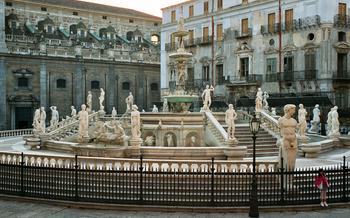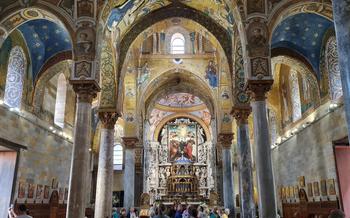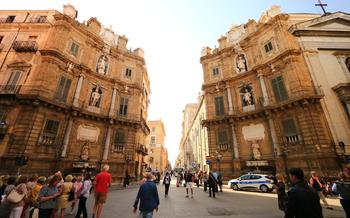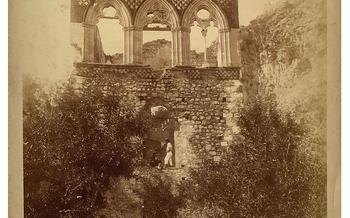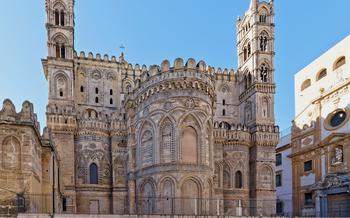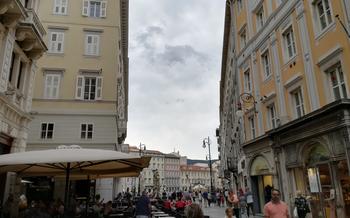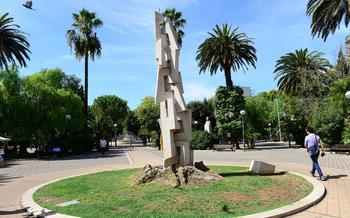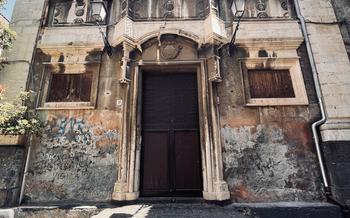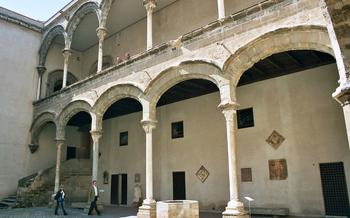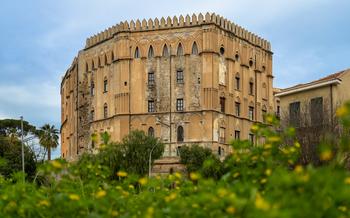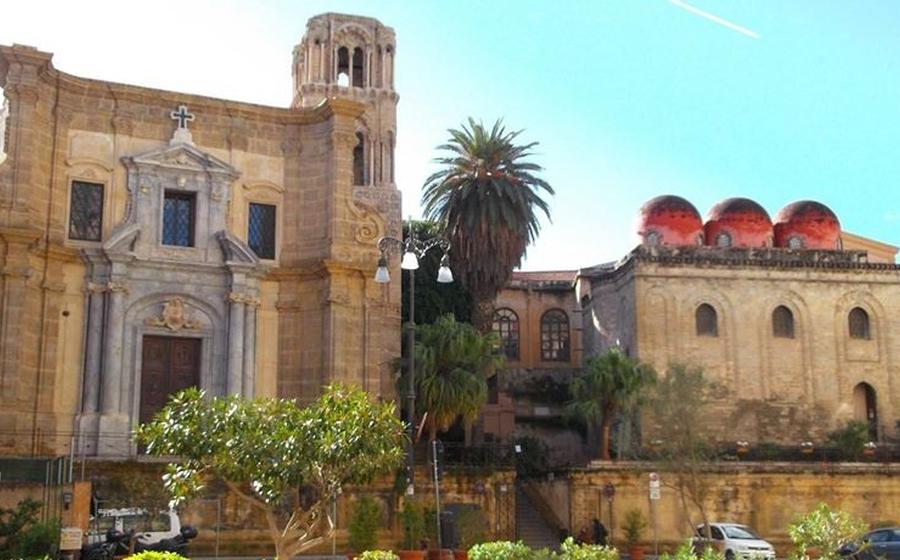
Piazza Bellini
- History and Significance
- Explore the Four Corners
- La Martorana Church
- San Cataldo Church
- Palazzo Pretorio
- Fountain of Pretoria
- Piazza Bellini's History
- Relax and Soak in the Atmosphere
- Attend Events and Festivals
- Nearby Markets
- Palermo's Street Food
- Nearby Churches
- Explore the Neighborhood
- Insider Tip
History and Significance
Palermo's Piazza Bellini, a small, charming square tucked between the bustling streets of the historic center, is a cultural and historical treasure trove that encapsulates the essence of the city. Steeped in history, the piazza has witnessed centuries of transformations, playing a pivotal role in Palermo's development.
Piazza Bellini's origins date back to the Arab domination of Sicily, when it was known as "Kalsa," a thriving neighborhood outside the city walls. In the 11th century, after the Norman conquest, it became a Christian quarter, and the square was renamed to honor the renowned composer Vincenzo Bellini, who lived nearby.
Strategically located at the crossroads of four ancient roads, Piazza Bellini served as a central hub for trade and commerce. It was here that merchants and travelers from across the Mediterranean converged, exchanging goods and ideas, leaving an indelible mark on the neighborhood's character.
Explore the Four Corners
Piazza Bellini is surrounded by four notable landmarks, each with its own unique history and architectural significance. Let's take a closer look at these iconic structures:
-
Chiesa della Martorana: Renowned for its exquisite Byzantine mosaics, this 12th-century church is a testament to Palermo's multicultural heritage. Its otherworldly interior features intricate depictions of biblical scenes and saints, creating a breathtakingly immersive experience.
-
San Cataldo Church: With its distinctive red domes, San Cataldo Church stands out as a symbol of Palermo's Arab-Norman heritage. Built in the 12th century, this unique structure features a blend of architectural styles and houses a rich history within its walls.
-
Palazzo Pretorio: Once the seat of Palermo's city government, Palazzo Pretorio is an impressive 15th-century building. Its grand facade is adorned with intricate carvings and sculptures, reflecting the power and prestige of the city's former rulers.
-
Fountain of Pretoria: Located in the center of the piazza, the Fountain of Pretoria is a true masterpiece of Renaissance art. Created by Florentine sculptor Francesco Camilliani in the 16th century, this elaborate fountain features a multitude of mythological figures and allegorical representations.
La Martorana Church
La Martorana, officially known as Santa Maria dell'Ammiraglio, is an exquisite example of Byzantine-Norman architecture, blending influences from both the East and the West. Founded in the 12th century by Admiral George of Antioch, it was part of a Benedictine monastery complex. Its striking exterior features a combination of limestone and lava stone, showcasing intricate carvings and decorative elements.
Inside, the church is adorned with a series of majestic Byzantine mosaics, depicting scenes from the Bible and the lives of saints. Shimmering in gold and vibrant hues, these mosaics have been meticulously preserved and offer a glimpse into the rich artistic heritage of the era. Particularly noteworthy are the mosaic of Christ Pantocrator in the central dome, the Annunciation in the apse, and the depiction of the Virgin Mary surrounded by angels.
Beyond its stunning mosaics, La Martorana boasts architectural highlights such as its pointed arches, delicate columns, and intricately carved capitals. The church's interior exudes a sense of grandeur and spirituality, making it a significant historical and cultural attraction in Palermo.
San Cataldo Church
San Cataldo Church, one of the four landmarks gracing Piazza Bellini, stands out with its distinctive red domes and unique architectural style. Its construction dates back to the 12th century, when it was commissioned by Maio of Bari, the Admiral of the Kingdom of Sicily. The church was dedicated to Saint Cataldo, an Irish monk who became the Bishop of Taranto in the 7th century.
San Cataldo's striking features include its three red domes, each supported by four pointed arches. These domes, reminiscent of Islamic architecture, create an arresting visual contrast to the church's otherwise austere exterior. The octagonal shape of the main dome, topped with a lantern, further enhances its uniqueness.
While the exterior of San Cataldo is relatively simple, its interior holds surprises. The nave, with its three apses, features an elegant simplicity that belies the church's historical significance. The pointed arches, supported by slender columns, create a sense of lightness and grace, while the absence of elaborate decorations allows the architectural elements to shine.
Palazzo Pretorio
Overlooking the bustling Piazza Bellini, Palazzo Pretorio stands as a testament to Palermo's rich history. Originally constructed in the 14th century as the seat of the city's government, it has witnessed countless events that have shaped Palermo's destiny.
The Palazzo's striking exterior boasts a blend of architectural styles, reflecting its diverse past. Its Gothic windows and Catalan-inspired balconies hint at the various rulers who have occupied the building over the centuries. The imposing tower, added in the 16th century, serves as a reminder of the palace's role as a defensive stronghold during tumultuous times.
Inside, the Palazzo's grand halls and ornate chambers have been meticulously restored to their former glory. Visitors can admire the intricate frescoes adorning the walls, depicting scenes from Palermo's history and mythology. The Sala delle Lapidi, with its collection of ancient inscriptions and sculptures, offers a glimpse into the city's rich cultural heritage.
Today, Palazzo Pretorio serves as Palermo's City Hall, a fitting tribute to its enduring significance. Its bustling offices and lively courtyards are a reminder of the vital role it continues to play in the city's governance.
Fountain of Pretoria
In the heart of Piazza Bellini, the magnificent Fountain of Pretoria stands as a testament to Renaissance art and Baroque excess. Commissioned in 1554 by a Florentine sculptor and later moved to its current location in 1575, this elaborate fountain is adorned with intricate carvings depicting mythological figures, animals, and allegorical representations.
The fountain's central basin is dominated by a bronze statue of Neptune, the Roman god of the sea, surrounded by a host of nymphs and tritons. Allegorical figures symbolizing rivers and seasons adorn the four corners of the fountain, while the upper basin features an array of mythological creatures, including satyrs, griffons, and lions.
Despite its artistic value, the Fountain of Pretoria has had a controversial history. It was initially criticized for its nudity, which was considered inappropriate for a public square. In the 17th century, the fountain was dismantled and its statues were moved to other locations. It was not until the 19th century that the fountain was reassembled and restored to its original glory.
Today, the Fountain of Pretoria remains a popular tourist attraction and a symbol of Palermo's rich artistic heritage. Visitors can admire its intricate details up close and marvel at the skill and artistry of its creators.
Piazza Bellini's History
Piazza Bellini has witnessed several historical events that have left an indelible mark on its character. During the Arab domination of Sicily, the piazza was known as "Suq al-Ballar," a bustling marketplace where traders from various parts of the Mediterranean would gather to exchange goods. After the Norman conquest in the 11th century, the piazza became a gathering place for the city's elite, and many noble families built their palaces in the surrounding area.
In the 16th century, the Spanish Inquisition established its tribunal in the Palazzo Pretorio, casting a dark shadow over the piazza. During this period, hundreds of suspected heretics were tried and condemned to death within the palazzo's walls.
In the 19th century, Piazza Bellini became a center of the Sicilian independence movement. In 1848, a group of rebels proclaimed the independence of Sicily from the Kingdom of Naples, and the piazza was the scene of fierce fighting between the rebels and the Neapolitan troops.
Throughout the 20th century, Piazza Bellini continued to be a hub of cultural and social life, hosting numerous events, concerts, and festivals. In recent years, it has undergone extensive restoration efforts, which have returned it to its former glory. Today, the piazza stands as a testament to Palermo's rich history and vibrant spirit.
Relax and Soak in the Atmosphere
Pause for a moment to savor the essence of Piazza Bellini. Settle into one of the cozy cafés that line the square and order a refreshing granita, the perfect pick-me-up on a warm day. As you sip your drink, let the vibrant energy of the piazza wash over you. Observe the locals going about their daily lives, the tourists snapping photos, and the street performers entertaining the crowd.
Immerse yourself in the lively atmosphere, letting the sounds of laughter, music, and conversations blend together to create a unique symphony of Palermo. People-watching is an art form here, so sit back, relax, and let the scene unfold before your eyes. You'll find that Piazza Bellini is not just a place to visit but a place to truly experience the vibrant soul of Palermo.
Attend Events and Festivals
Piazza Bellini comes alive during various cultural events, concerts, and festivals throughout the year. These events offer a unique opportunity to immerse yourself in the vibrant atmosphere and traditions of Palermo. From classical music concerts to street performances, there's something for everyone.
To find out about upcoming events, check local tourism websites or ask at your hotel or a local tourist information center. Some popular events include the Festino di Santa Rosalia, a religious festival honoring the patron saint of Palermo, and the Palermo Summer Festival, which features a series of cultural events and performances.
Attending an event or festival in Piazza Bellini is a fantastic way to experience the city's passion for the arts and culture. Whether you're a music lover, history buff, or simply looking for a lively atmosphere, you're sure to find something to enjoy.
Nearby Markets
A trip to Palermo is not complete without exploring its bustling markets. Just a short walk from Piazza Bellini, you can find two of the city's most vibrant markets: Ballarò Market and Vucciria Market.
Lose yourself in the maze-like alleys of the Ballarò Market, where you'll be surrounded by colorful stalls selling local produce, freshly caught seafood, spices, and traditional sweets. Enjoy the lively atmosphere as vendors eagerly showcase their goods and shoppers haggle for the best prices.
The Vucciria Market, located near the port, offers a different kind of experience. Here, you'll find a mix of local delicacies, handmade crafts, and vintage items. Browse through the stalls of local artisans selling unique souvenirs, from intricate ceramic pieces to handmade jewelry.
Both markets are a feast for the senses, where you can soak in the vibrant local culture and sample some of Palermo's culinary delights. Don't miss the chance to try the local street food offerings, such as freshly fried arancini (rice balls filled with meat or cheese) or pani ca meusa (spleen sandwich).
Palermo's Street Food
Palermo is renowned for its vibrant street food scene, and Piazza Bellini is no exception. Indulge in the flavors of Sicily by sampling local delicacies like the iconic arancini, crispy fried rice balls stuffed with various fillings such as ragù, peas, cheese, or pistachio cream. Another must-try is pani ca meusa, a delicious sandwich filled with spleen, ricotta cheese, and lemon. For a sweet treat, don't miss the cannoli, crispy pastry shells filled with a sweet ricotta filling.
Strolling through the streets surrounding Piazza Bellini, you'll find numerous food stalls and vendors selling these local specialties. Be sure to try sfincione, a thick focaccia bread topped with tomato sauce, cheese, and anchovies, or stigghiole, grilled lamb intestines. For a refreshing drink, try a glass of granita, a Sicilian shaved ice dessert flavored with fresh fruits or coffee.
Palermo's street food is an integral part of the city's culinary identity. Join the locals and savor the mouthwatering flavors as you wander through the charming streets of the city center.
Nearby Churches
In addition to San Cataldo and La Martorana, several other notable churches are located in the vicinity of Piazza Bellini. Each possesses unique features and historical significance, contributing to the rich religious heritage of Palermo.
One such church is the Chiesa di San Giovanni degli Eremiti, renowned for its striking red domes and bell tower, a symbol of the city's skyline. Built in the 12th century, it showcases a blend of Arabic and Norman architectural styles, reflecting the diverse cultural influences that shaped Palermo's past.
Another noteworthy church is the Chiesa di Santa Caterina d'Alessandria, located just a short walk from Piazza Bellini. This Baroque masterpiece boasts an opulent façade adorned with intricate sculptures and colorful tiles. Its interior features stunning frescoes, marble altars, and a remarkable collection of religious artifacts.
For those interested in exploring further, the Chiesa del Santo Spirito is another hidden gem in the area. Founded in the 15th century, it houses valuable works of art, including paintings by renowned Sicilian artists such as Antonello da Messina and Vincenzo Gagini.
These churches, along with many others, form an integral part of Palermo's religious history and cultural landscape. Strolling through the charming streets of the city center, visitors can discover these sacred spaces and delve deeper into the rich tapestry of the city's past.
Explore the Neighborhood
Strolling through the labyrinthine streets branching off from Piazza Bellini is like stepping back in time. The neighborhood is a treasure trove of hidden gems, each with a story to tell. Admire the faded grandeur of Palazzo Chiaramonte, once home to a powerful noble family. Seek out the Chiesa di San Giovanni degli Eremiti, with its captivating Norman-Arab architecture and cloister garden. Get lost in the vibrant Ballarò Market, a riot of colors, sounds, and tantalizing aromas. Discover local artisans in their workshops, crafting exquisite ceramics, intricate jewelry, and traditional Sicilian marionettes. In the evening, immerse yourself in the lively atmosphere of Via Maqueda, lined with charming restaurants, bars, and boutiques. No matter where you wander, the neighborhood surrounding Piazza Bellini offers a feast for the senses and a glimpse into Palermo's rich history and vibrant culture.
Insider Tip
To experience the tranquil ambiance of Piazza Bellini, venture out early in the morning before the bustling crowds arrive. As the city slowly awakens, you'll have the chance to relish the piazza's charm without the throngs of tourists. Take advantage of this serene atmosphere to capture stunning photographs of the square's architectural wonders bathed in the soft morning light.
Delve deeper into the heart of Palermo by exploring the workshops of local artisans tucked away in the narrow alleyways surrounding the piazza. Discover the artistry of these skilled craftsmen as they create unique pieces of pottery, leather goods, and jewelry. Engage with them, learn about their techniques, and perhaps even purchase a handmade souvenir to cherish as a memento of your time in Palermo.
